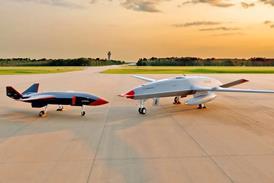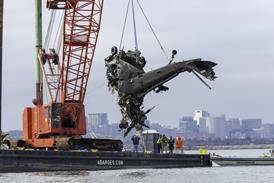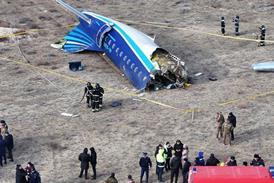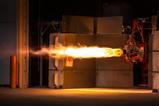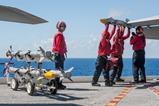The US Army is taking a more aggressive approach to fielding its new Bell MV-75 tiltrotor, with officials saying they will accept some risks in the design phase to accelerate delivery of the next-generation troop carrier.
Those risks, which are more financial and technical than physical, include the likelihood of issuing low-rate production authority to developer Bell before fully completing the initial engineering and manufacturing development phase of the Future Long-Range Assault Aircraft (FLRAA) programme.
That exhaustive process normally takes years of evaluations and prototype testing leading up to what is known as Milestone C in Pentagon parlance – a formal acquisition decision certifying the design meets all requirements and standards.
“Normally, a production decision is tied to Milestone C,” says Colonel Jeffrey Poquette, the army’s FLRAA programme manager. “But we’re going to have an early production decision ahead of Milestone C.”
Poquette spoke to FlightGlobal at the 2025 Army Aviation Association of America conference in Nashville, Tennessee earlier this month.

The goal of such a move, Poquette notes, is to minimise the gap between the delivery of prototype MV-75s and operationally-configured production aircraft – potentially shaving a year or two off the fielding timeline.
Bell is under contract to supply eight MV-75 prototypes. Under normal acquisition procedures, the army would conduct extensive flight trials with those aircraft, assess whether they meet the service’s needs and suggest changes for a final design.
Such an approach allows the Pentagon to catch performance issues and design flaws and avoid costly retrofits.
With the MV-75, Poquette says the army is willing to accept some of those risks in exchange for shaving some time off the delivery of fully operational tiltrotors to frontline units.
“Rather than pursue perfect, we are pursuing an aircraft that is close to being what we asked for,” he says.
The army previously established strict minimum thresholds for speed, range and open-source digital features for easily integrating new capabilities.
While Poquette says the army’s goal is still for Bell to meet all of those targets, he adds that chief of staff General Randy George has placed a higher priority on fielding the new tiltrotor sooner, rather than “design yourself to death”.
“The chief wants to get this weapon system into the hands of war fighters sooner,” Poquette notes. “He’s willing to accept that risk.”
That is not to say the army or Bell expect to miss any performance targets on the MV-75.
Poquette says the digital design and modelling techniques used by Bell give the army “tremendous insight and confidence” that the prototype tiltrotor design will meet its operational needs with minimal to no modifications.
Bell already knows its design can meet the army’s flight performance guidelines, based on testing with the company’s V-280 Valor demonstrator that secured the FLRAA contract win over a compound-coaxial proposal from Sikorsky. The focus now is proving the manufacturing process to support large-scale deliveries of standardised aircraft.
“A lot of the work that we’re doing right now is… simulated assembly in the digital environment [and] maintenance in the digital environment,” says Ryan Ehinger, Bell’s FLRAA programme director.
Extensive modelling of how the MV-75 will perform in flight, how it will be assembled and how frontline maintainers will access onboard components can mitigate many of the issues normally discovered during prototype testing, Ehinger says.
“So, that gap between prototype production and early production aircraft isn’t necessarily needed,” he notes.

Bell aims to deliver its first MV-75 prototype to the army in 2027, with a first flight coming that same year. The delivery will be preceded by a critical design review (CDR) in 2026, which will indicate whether the army’s accelerated fielding plan remains viable.
If that review goes well, Poquette says the army will release long-lead funding for Bell to begin purchasing components and materials needed for assembling production aircraft, rather than just the prototypes already under contract.
That CDR has been pushed back by nine months from its original date in 2025. Poquette says the change will allow the army to ensure the initial MV-75 prototype design meets its long-term needs, ultimately shortening the aircraft’s test campaign and accelerating the start of rate production.
“We’ll be able to… build the right prototypes from the get-go,” Poquette says. “Which is why we’re comfortable going into production during the test and why we think tests will be much shorter.”
Such a decision on production will still happen after Bell has delivered at least a portion of the MV-75 prototype fleet, allowing for at least a partial test and evaluation campaign.
While the fast-track approach carries risk, Poquette says the army examined the US Marine Corps’ (USMC’s) experience with fielding the Bell-Boeing V-22 Osprey and Sikorsky CH-53K King Stallion and decided it needed to speed things up.
“Those programmes, CH-53K and V-22, took a long time to get through tests and get to initial operational capability, he notes. “On the order of 18 to 20 years.”
By contrast, if the current timeline holds, the FLRAA programme could reach initial operational capability just nine years after the effort was launched. The army aims to field its first tiltrotor to a frontline unit by 2030 or sooner.
Another lesson drawn from the early V-22 development effort, according to Poquette, is not to conduct operational testing and developmental testing concurrently.
“We’re not going to do that because it didn’t work out very well for them,” he notes.
Developmental testing covers basic safety and airworthiness evaluations by experimental test pilots. Following that, operational testing begins with frontline aviators putting the prototype aircraft through mock missions to simulate conditions under which it will operate in the real world.
In the case of the MV-75, this will include loading and unloading troops on unprepared landing zones and delivering sling-load cargo hung beneath the fuselage.
In practical terms, the accelerated test and production changes could see the army fielding its first two battalions of MV-75s – 48 aircraft in total – roughly two-and-half years ahead of the original schedule.
As the genealogical successor to the V-22, Ehinger says the MV-75 incorporates years of learning on how to improve tiltrotor design, flight operations and maintenance procedures.
Part of that analysis included reviewing the top 100 maintenance issues associated with the Osprey and the development of solutions to address them.
“How do we get rid of that component, redesign that component, change the environment for that component?” Ehinger says. “We incorporated that into this platform from the early conceptual design.”

One major change from the Osprey, which features fully rotating engine nacelles for transitioning between vertical and horizontal flight, is that the MV-75’s two wing-mounted Rolls-Royce engines will remain static. Only the rotors and gearboxes will rotate on the new tiltrotor – simplifying the design and hopefully improving reliability.
Those design changes, and investments from Bell into advanced manufacturing, will give the MV-75 a total cost equal to half that of the Osprey, according to Poquette.
A new V-22 carries an average flyaway cost of $75 million, according to fiscal year 2025 Pentagon budget documents. Standard model MV-22s tend to cost less, while speciality CV-22 and CMV-22B variants are more expensive.
While the army is still working out its acquisition target for the MV-75, amid a major shake-up to the service’s aviation strategy, Poquette says the plan is for a “very significant number” of tiltrotors to be fielded.
“It doesn’t replace the entire Black Hawk fleet, but a strong majority,” he reveals. “So we’re talking over 1,000.”
The army’s fleet of Sikorsky UH-60 Black Hawks numbers around 2,300.
“We see that this production line will be open for many decades, similar to our previous or existing fleets,” Poquette says of the MV-75.
Bell plans to complete final assembly of the new aircraft in Amarillo, Texas – the same location where it currently produces Ospreys. US orders will keep the Osprey line hot through the end of 2027.
Conclusion of V-22 production is now in sight, with delivery of the final US Air Force CV-22 coming this year and the USMC fleet of 360 MV-22s nearly filled out.
Despite cuts to some of its aviation assets, including older Boeing AH-64D attack helicopters and the cancellation of a new armed scout platform last year, army brass say the MV-75 will move forward.
“We are 100% committed to FLRAA,” army vice chief of staff General James Mingus told FlightGlobal in Nashville. “Not just committed to the programme, but how do we do it faster.”





